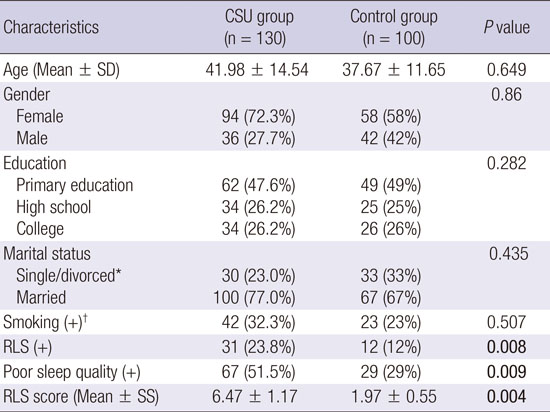1. Wali SO, Abaalkhail B. Prevalence of restless legs syndrome and associated risk factors among middle-aged Saudi population. Ann Thorac Med. 2015; 10:193–198.
2. Gupta R, Lahan V, Goel D. Prevalence of restless leg syndrome in subjects with depressive disorder. Indian J Psychiatry. 2013; 55:70–73.
3. Thorburn PT, Riha RL. Skin disorders and sleep in adults: where is the evidence? Sleep Med Rev. 2010; 14:351–358.
4. Kaplan AP. Chronic urticaria and angioedema. N Engl J Med. 2002; 346:175–179.
5. Yosipovitch G, Ansari N, Goon A, Chan YH, Goh CL. Clinical characteristics of pruritus in chronic idiopathic urticaria. Br J Dermatol. 2002; 147:32–36.
6. Zuberbier T, Aberer W, Asero R, Bindslev-Jensen C, Brzoza Z, Canonica GW, Church MK, Ensina LF, Giménez-Arnau A, Godse K, et al. The EAACI/GA(2) LEN/EDF/WAO Guideline for the definition, classification, diagnosis, and management of urticaria: the 2013 revision and update. Allergy. 2014; 69:868–887.
7. Allen RP, Picchietti D, Hening WA, Trenkwalder C, Walters AS, Montplaisi J. Restless Legs Syndrome Diagnosis and Epidemiology workshop at the National Institutes of Health; International Restless Legs Syndrome Study Group. Restless legs syndrome: diagnostic criteria, special considerations, and epidemiology. A report from the restless legs syndrome diagnosis and epidemiology workshop at the National Institutes of Health. Sleep Med. 2003; 4:101–119.
8. Walters AS, LeBrocq C, Dhar A, Hening W, Rosen R, Allen RP, Trenkwalder C; International Restless Legs Syndrome Study Group. Validation of the International Restless Legs Syndrome Study Group rating scale for restless legs syndrome. Sleep Med. 2003; 4:121–132.
9. Buysse DJ, Reynolds CF 3rd, Monk TH, Berman SR, Kupfer DJ. The Pittsburgh Sleep Quality Index: a new instrument for psychiatric practice and research. Psychiatry Res. 1989; 28:193–213.
10. Ağargün MY, Kara H, Anlar Ö. The validity and reliability of the Pittsburgh Sleep Quality Index. Turk Psikiyatr Derg. 1996; 7:107–115.
11. Chiba S. Sleep psychiatry. Seishin Shinkeigaku Zasshi. 2013; 115:782–791.
12. Fietze I, Nötzel K, Blau A, Glos M, Penzel T. Portable sleep monitoring in patients with disorders in falling asleep or maintaining sleep. Nervenarzt. 2012; 83:1021–1027.
13. Allen RP, Earley CJ. Restless legs syndrome: a review of clinical and pathophysiologic features. J Clin Neurophysiol. 2001; 18:128–147.
14. Maurer M, Ortonne JP, Zuberbier T. Chronic urticaria: an internet survey of health behaviours, symptom patterns and treatment needs in European adult patients. Br J Dermatol. 2009; 160:633–641.
15. Bender BG, Ballard R, Canono B, Murphy JR, Leung DY. Disease severity, scratching, and sleep quality in patients with atopic dermatitis. J Am Acad Dermatol. 2008; 58:415–420.
16. Zachariae R, Lei U, Haedersdal M, Zachariae C. Itch severity and quality of life in patients with pruritus: preliminary validity of a Danish adaptation of the itch severity scale. Acta Derm Venereol. 2012; 92:508–514.
17. Alan S, Canan F, Karakaş AA, Geçici N. Temperament and character profiles of patients with chronic idiopathic urticaria. Postepy Dermatol Alergol. 2015; 32:167–172.
18. Trenkwalder C, Paulus W. Why do restless legs occur at rest?--pathophysiology of neuronal structures in RLS. Neurophysiology of RLS (part 2). Clin Neurophysiol. 2004; 115:1975–1988.
19. Suzuki K, Miyamoto M, Miyamoto T, Hirata K. Restless legs syndrome and leg motor restlessness in Parkinson's disease. Parkinsons Dis. 2015; 2015:490938.
20. García-Borreguero D. Dopaminergic augmentation in restless legs syndrome/Willis-Ekbom disease: identification and management. Sleep Med Clin. 2015; 10:287–292.









 PDF
PDF ePub
ePub Citation
Citation Print
Print





 XML Download
XML Download